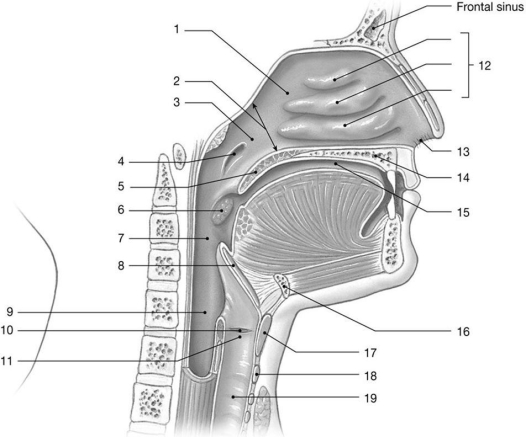A) apneustic
B) pneumotaxic
C) expiratory
D) baroreceptor
E) chemoreceptor
Correct Answer

verified
Correct Answer
verified
Multiple Choice
At a PO2 of 70 mm Hg and normal temperature and pH, hemoglobin is ________ percent saturated with oxygen.
A) 10
B) 25
C) 50
D) 75
E) more than 90
Correct Answer

verified
Correct Answer
verified
Multiple Choice
The laryngeal cartilage which is not composed of hyaline cartilage is the
A) arytenoid.
B) corniculate.
C) cricoid.
D) epiglottis.
E) thyroid.
Correct Answer

verified
Correct Answer
verified
Multiple Choice
________ is the amount of air that moves into the respiratory system during a single respiratory cycle.
A) Residual volume
B) Expiratory reserve volume
C) Inspiratory reserve volume
D) Tidal volume
E) Inspiratory capacity
Correct Answer

verified
Correct Answer
verified
Multiple Choice
________ is the amount of air that you can inhale above the resting tidal volume.
A) Residual inhaled volume
B) Expiratory reserve volume
C) Inspiratory reserve volume
D) Enhanced tidal volume
E) Inspiratory capacity
Correct Answer

verified
Correct Answer
verified
Multiple Choice
The process by which dissolved gases are exchanged between the cells and interstitial fluids is
A) pulmonary ventilation.
B) external respiration.
C) internal respiration.
D) cellular respiration.
E) breathing.
Correct Answer

verified
Correct Answer
verified
Multiple Choice
Figure 23-1 The Upper Airways
 Use Figure 23-1 to answer the following questions:
-Identify the structure labeled "7."
Use Figure 23-1 to answer the following questions:
-Identify the structure labeled "7."
A) internal nares
B) esophagus
C) glottis
D) oropharynx
E) laryngopharynx
Correct Answer

verified
Correct Answer
verified
Multiple Choice
________ is the most common lethal inherited disease affecting individuals of Northern European descent.
A) MRSA
B) Congestive heart failure
C) Cystic fibrosis
D) Myasthenia gravis
E) Parkinson's disease
Correct Answer

verified
Correct Answer
verified
Multiple Choice
The Hering-Breuer reflex
A) functions to increase ventilation with changes in blood pressure.
B) alters pulmonary ventilation when the PO2 changes.
C) alters pulmonary ventilation when the PCO2 changes.
D) protects the lungs from damage due to overinflation.
E) is an important aspect of normal, quiet breathing.
Correct Answer

verified
Correct Answer
verified
Multiple Choice
The larynx, trachea, bronchi, and bronchioles all make up the
A) upper respiratory tract.
B) lower respiratory tract.
C) internal respiratory tract.
D) alveoli of the respiratory tract.
E) respiratory mucosa.
Correct Answer

verified
Correct Answer
verified
Multiple Choice
The largest cartilage of the larynx is the ________ cartilage.
A) thyroid
B) cricoid
C) cuneiform
D) arytenoid
E) epiglottic
Correct Answer

verified
Correct Answer
verified
Multiple Choice
The larynx contains ________ cartilages.
A) 14
B) 6
C) 9
D) 2
E) 5
Correct Answer

verified
Correct Answer
verified
Multiple Choice
Lung tissue receives oxygen and nutrients from the
A) pleural arteries.
B) pulmonary arteries.
C) pulmonary veins.
D) coronary arteries.
E) bronchial arteries.
Correct Answer

verified
Correct Answer
verified
Multiple Choice
Most of the oxygen transported by the blood is
A) dissolved in plasma.
B) bound to hemoglobin.
C) in ionic form as solute in the plasma.
D) bound to the same protein as carbon dioxide.
E) carried by white blood cells.
Correct Answer

verified
Correct Answer
verified
Multiple Choice
The C shape of the tracheal cartilages is important because
A) large masses of food can move through the esophagus.
B) large masses of air can pass through the trachea and thus the bronchi.
C) it facilitates turning of the head.
D) the bronchi are also C-shaped.
E) it permits the trachea to pinch shut prior to sneezing.
Correct Answer

verified
Correct Answer
verified
Multiple Choice
Primary bronchi enter their respective lungs along with pulmonary vessels, nerves, and lymphatics at whichregion?
A) base
B) apex
C) hilum
D) cardiac notch
E) superior lobe
Correct Answer

verified
Correct Answer
verified
Multiple Choice
Tina is singing a song. At a certain point in the song, she forces a large volume of air out of the glottisand at the same time increases the tension on her vocal cords. The sound that she produces is
A) low pitched and loud.
B) high pitched and loud.
C) low pitched and soft.
D) high pitched and soft.
E) medium pitched and soft.
Correct Answer

verified
Correct Answer
verified
Multiple Choice
Each 100 ml of blood leaving the alveolar capillaries carries away roughly ________ ml of oxygen.
A) 10
B) 20
C) 30
D) 50
E) 75
Correct Answer

verified
Correct Answer
verified
Multiple Choice
The conchae
A) divide the nasal cavity into a right and a left side.
B) provide an opening into the pharynx.
C) provide a increase in surface area for the sense of smell.
D) create turbulence in the air to trap particulate matter in mucus.
E) provide an opening to paranasal sinuses.
Correct Answer

verified
Correct Answer
verified
Multiple Choice
The right lung is to ________ as the left lung is to ________.
A) three lobes; two lobes
B) two lobes; two lobes
C) two lobes; three lobes
D) three lobes; three lobes
E) four lobes; three lobes
Correct Answer

verified
Correct Answer
verified
Showing 141 - 160 of 200
Related Exams